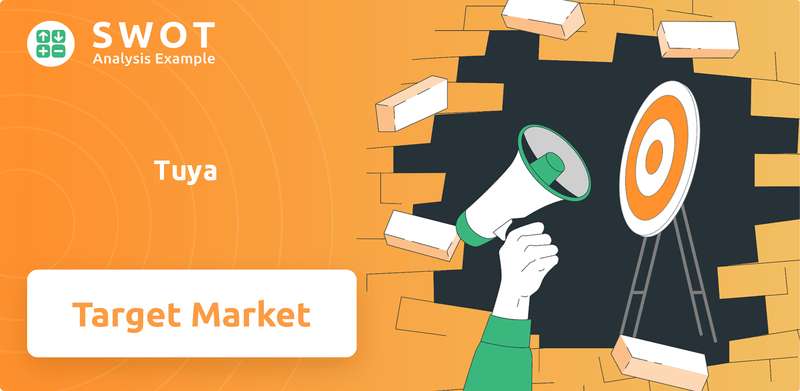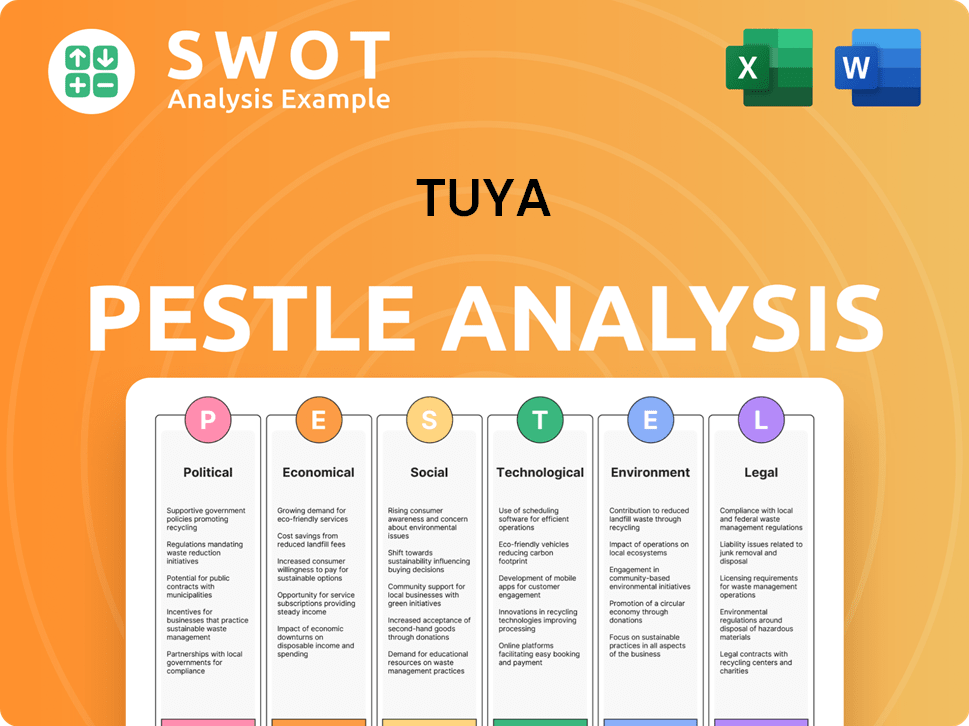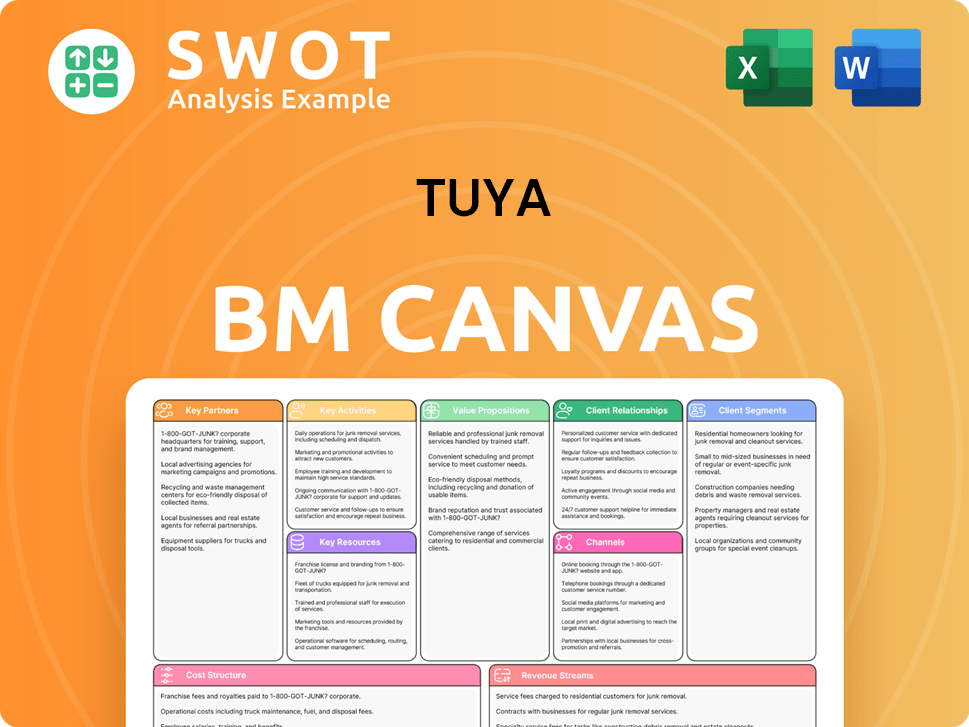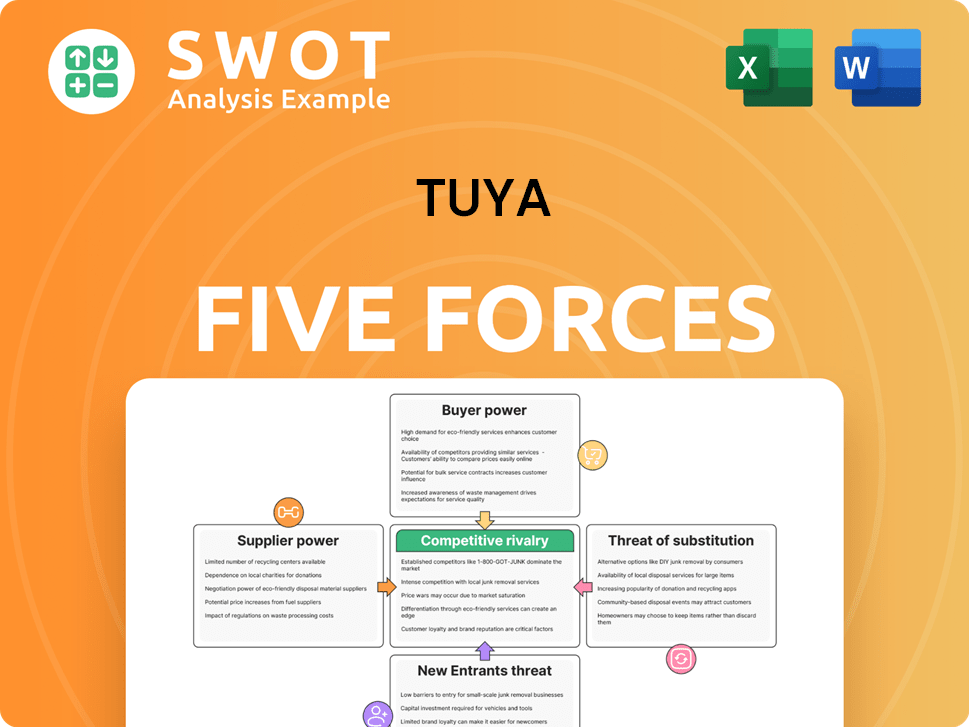Tuya Bundle
Who are Tuya Company's Customers?
In the dynamic world of IoT, understanding customer demographics is key to success. For Tuya Company, a leading AI cloud platform, identifying its target market is crucial for growth. This analysis dives deep into Tuya's customer base, revealing the key segments driving its impressive expansion in the smart home market.

This exploration of Tuya's Tuya SWOT Analysis will uncover the specifics of its customer demographics and target market. We'll examine Tuya users, including their age range, location data, and income levels, to understand their needs and preferences. Furthermore, we will analyze Tuya's customer segmentation strategies and acquisition methods, providing a comprehensive view of who uses the Tuya platform and how the company caters to its ideal customer profile within the smart home market.
Who Are Tuya’s Main Customers?
Understanding the customer base of the [Company Name] involves recognizing its primary focus on business-to-business (B2B) operations. The company operates as a global IoT development platform, providing services to a diverse range of businesses. This includes original equipment manufacturers (OEMs), brands, and system integrators. These entities leverage the platform to create smart devices and solutions, making the company a key player in the smart home market.
The company's customer demographics are primarily within the B2B sector, encompassing a wide spectrum from large enterprises to small and medium-sized industry developers. While the brand's visibility might be lower among end-consumers, its influence is strong within the B2B manufacturing and development sectors. This strategic positioning is crucial to understanding the company's market dynamics and growth trajectory.
A significant portion of the company's revenue stems from its 'premium IoT PaaS customers.' These are defined as those spending over US$100,000 annually, highlighting a focus on high-value clients. This customer segment is critical to the company's financial performance and strategic direction.
In the first quarter of 2025, the company had 287 premium customers. These customers contributed approximately 88.7% of the company's IoT PaaS revenue. This is an increase from 85.1% in Q1 2024, showing a growing reliance on high-value clients.
The company reported around 1.32 million registered developers by the end of 2024. This large developer base is crucial for the continued expansion and innovation of the platform, driving the growth of the company's ecosystem.
The company's IoT PaaS revenue increased by 29.4% to US$217.1 million in 2024. This growth reflects the increasing demand for the company's platform and services within the smart home market. It also demonstrates the effectiveness of the company's customer acquisition strategies.
The company saw substantial growth in smart solution revenue, up 58.3% to US$42.0 million in 2024. This increase is driven by rising customer demand for smart devices with integrated intelligent software capabilities. This indicates the company's ability to adapt to market demands.
The company's target market analysis reveals a strategic focus on B2B clients, particularly those with high revenue potential. This focus is evident in the growth of premium customers and the substantial revenue generated from IoT PaaS services. Understanding the company's customer demographics is essential for grasping its market position.
- OEMs and Brands: Companies that use the platform to develop and manufacture smart devices.
- System Integrators: Businesses that integrate smart solutions into various systems.
- Premium IoT PaaS Customers: High-value clients contributing significantly to revenue.
- Registered Developers: A large community driving innovation and platform expansion.
To delve deeper into the company's strategic approach and market positioning, consider exploring the Marketing Strategy of Tuya.
Tuya SWOT Analysis
- Complete SWOT Breakdown
- Fully Customizable
- Editable in Excel & Word
- Professional Formatting
- Investor-Ready Format

What Do Tuya’s Customers Want?
Understanding the customer needs and preferences of the [Company Name] is crucial for tailoring products and services effectively. The company primarily serves businesses and developers within the smart home market, focusing on providing solutions that facilitate the rapid development and deployment of smart devices.
The core needs of [Company Name]'s customers revolve around ease of use, versatility, and cost-effectiveness. They seek a platform that simplifies the complexities of Internet of Things (IoT) development, allowing them to quickly bring innovative smart products to market. This includes access to a comprehensive cloud platform, seamless integration capabilities, and robust data protection measures.
The psychological drivers behind choosing [Company Name]'s offerings are centered on the desire to capitalize on the growing demand for smart living and business solutions. Customers want to be at the forefront of technological advancements, offering their consumers cutting-edge smart products. This is supported by the company's commitment to innovation and its ability to adapt to the changing needs of its customer base.
Customers prioritize platforms that enable the quick and easy creation of smart devices. This includes tools and resources that reduce the time and effort required for development.
Access to a versatile cloud platform is essential. This platform should support a wide range of devices and offer seamless integration with various communication protocols and voice assistants.
Customers look for solutions that reduce both technical and financial barriers. This allows for efficient exploration of AI product forms and functions, making innovation accessible.
Purchasing behaviors favor platforms that offer a complete suite of services, including Platform-as-a-Service (PaaS) and Software-as-a-Service (SaaS) options. This simplifies the development process.
Robust data protection and safety protocols are critical for maintaining technological reliability and building customer trust. Security is a top priority.
Customers are increasingly interested in AI integration. Solutions that address the complexities and costs associated with AI adoption are highly valued.
Addressing the pain points of its customers is a key focus for [Company Name]. These pain points include the complexities of IoT development, interoperability challenges, and the high costs associated with AI integration. The company's integration with leading large language model providers and its offering of AI Token free plans directly tackle these challenges, making AI more accessible for small and medium-sized industry developers. For example, the company's partnerships with industry leaders like Apple and Amazon Web Services, as well as collaborations like the one with Chery, demonstrate its adaptability to specific segment needs. To learn more about the company's history, you can read the Brief History of Tuya.
The preferences of the company's customers are shaped by the need for a comprehensive and user-friendly platform. This includes a focus on ease of use, versatility, and cost-effectiveness. The company's commitment to innovation and its ability to adapt to the changing needs of its customer base is also a significant factor.
- Full Suite of Offerings: Customers prefer platforms that offer a full suite of services, including PaaS and SaaS options, to streamline development.
- Versatility: The platform's ability to support a wide variety of devices and work 'out of the box' is a significant preference, ensuring ease of integration.
- Data Protection: Robust data protection and safety protocols are a top priority, ensuring technological reliability and building customer trust.
- AI Integration: Addressing the complexities and costs associated with AI adoption is a key focus, making AI more accessible for developers.
Tuya PESTLE Analysis
- Covers All 6 PESTLE Categories
- No Research Needed – Save Hours of Work
- Built by Experts, Trusted by Consultants
- Instant Download, Ready to Use
- 100% Editable, Fully Customizable

Where does Tuya operate?
The geographical market presence of the [Company Name] is substantial, with operations extending across over 220 countries and regions globally. While firmly established in its domestic market within China, [Company Name] has also achieved significant international penetration. This expansion is particularly notable in regions like Europe and North America, where the company is actively growing its smart home technology ecosystem and industrial IoT solutions.
The Asia-Pacific region is a major contributor to [Company Name]'s global revenue. In 2024, the company's global revenue reached US$322 million, with a significant portion coming from the APAC region. This highlights the importance of this area in [Company Name]'s overall financial performance and market strategy.
The company's approach to customer demographics and preferences varies across different regions. For example, in Europe, [Company Name] upgraded its headquarters in Düsseldorf, Germany, in November 2024. This move supports the rapidly growing European smart market and offers more tailored services, with collaborations with leading European brands. These strategic moves are part of [Company Name]'s efforts to adapt to local market needs and consumer behaviors.
The company is committed to advancing the digital economy in Southeast Asia. This is demonstrated by its participation in the Global Telecom AIoT Summit 2025. These initiatives show [Company Name]'s dedication to expanding its presence and influence in the region.
The strategic distribution of sales and growth across different regions helps [Company Name] reduce its dependence on any single market. This diversification allows the company to capitalize on emerging opportunities worldwide. This approach is crucial for sustainable growth.
The company's international expansion, particularly in Europe and North America, is focused on growing its smart home technology ecosystem and industrial IoT solutions. This expansion is part of its strategy to increase its market share and reach a broader customer base.
The company's global strategy includes understanding and adapting to the unique needs of its Tuya target market in each region, which is essential for sustained growth and market leadership. The company's ability to adapt to local market conditions and customer preferences is a critical factor in its global success. The company aims to cater to different
Tuya Business Model Canvas
- Complete 9-Block Business Model Canvas
- Effortlessly Communicate Your Business Strategy
- Investor-Ready BMC Format
- 100% Editable and Customizable
- Clear and Structured Layout

How Does Tuya Win & Keep Customers?
Customer acquisition and retention strategies for the [Company Name] are designed to leverage its position as a global IoT development platform. The strategies focus on attracting businesses and developers by offering a comprehensive platform that simplifies smart device creation and deployment. This approach is crucial for expanding its user base and maintaining a strong foothold in the competitive smart home market.
The company's strategy involves a multifaceted approach that includes industry conferences and developer events, such as the 'TUYA Global Developer Conference' and 'Tuya Developer Day' at CES 2025, to showcase its latest AI innovations. Additionally, initiatives such as the 'AI Token free plan' are employed to reduce barriers to entry for developers, encouraging them to utilize the platform. These efforts are vital for attracting new customers and fostering innovation within the Tuya platform.
For customer retention, the company emphasizes building a strong global developer community and fostering deep ecosystem integration. This is supported by a key-account strategy, which focuses on serving 'premium IoT PaaS customers' that contribute significantly to its revenue. The company's ability to focus on customer needs and product enhancements, driven by customer data and segmentation, has fueled increased demand for its IoT PaaS revenue. Furthermore, strategic partnerships with major players like Google Home and Amazon Web Services enhance the platform's value proposition, driving both acquisition and retention.
The company acquires customers by providing a comprehensive IoT development platform. Marketing efforts include industry events such as 'TUYA Global Developer Conference' and 'Tuya Developer Day' at CES 2025. These events showcase cutting-edge AI innovations and new AI development tools, attracting potential users.
The 'AI Token free plan' is a significant acquisition tactic. This initiative reduces technical and cost barriers. It encourages developers to access and utilize powerful AI resources, thereby expanding the user base.
Retention strategies involve building a strong global developer community. Deep ecosystem integration is also a key focus. These strategies enhance customer loyalty and ensure long-term platform use.
The company focuses on serving 'premium IoT PaaS customers'. These customers contribute a significant portion of the IoT PaaS revenue. This key-account strategy ensures that the most valuable customers are well-supported.
The company's dollar-based net expansion rate (DBNER) for IoT PaaS was 122% for the trailing 12 months ended December 31, 2024, and 118% for the trailing 12 months ended March 31, 2025, indicating strong retention and upselling. The top 10% customer retention rate was approximately 97% by the end of 2024. The increasing demand for smart devices with integrated intelligent software drove smart solution revenue, which increased by 47.1% in Q1 2025. For more insights into the company's business model, consider reading about the Revenue Streams & Business Model of Tuya.
The company uses customer data to focus on customer needs and product enhancements. This approach fuels increasing demand for its IoT PaaS revenue. This data-driven approach helps tailor products and services.
Partnerships with Google Home and Amazon Web Services enhance the value proposition. These partnerships ensure compatibility and seamless integration. They serve as both acquisition and retention drivers.
There is a greater emphasis on AI integration and offering comprehensive smart solutions. This has impacted customer loyalty and lifetime value. The company continuously adapts to market changes.
Smart solution revenue increased by 47.1% in Q1 2025. This growth is driven by increasing customer demand for smart devices. It highlights the effectiveness of the company's strategies.
The company focuses on 'premium IoT PaaS customers'. These customers contribute a significant portion of the company's revenue. This targeted approach ensures customer satisfaction and retention.
Building a vibrant global developer community is a key retention strategy. This community fosters innovation and provides support. It ensures developers remain engaged with the platform.
Tuya Porter's Five Forces Analysis
- Covers All 5 Competitive Forces in Detail
- Structured for Consultants, Students, and Founders
- 100% Editable in Microsoft Word & Excel
- Instant Digital Download – Use Immediately
- Compatible with Mac & PC – Fully Unlocked

Related Blogs
- What are Mission Vision & Core Values of Tuya Company?
- What is Competitive Landscape of Tuya Company?
- What is Growth Strategy and Future Prospects of Tuya Company?
- How Does Tuya Company Work?
- What is Sales and Marketing Strategy of Tuya Company?
- What is Brief History of Tuya Company?
- Who Owns Tuya Company?
Disclaimer
All information, articles, and product details provided on this website are for general informational and educational purposes only. We do not claim any ownership over, nor do we intend to infringe upon, any trademarks, copyrights, logos, brand names, or other intellectual property mentioned or depicted on this site. Such intellectual property remains the property of its respective owners, and any references here are made solely for identification or informational purposes, without implying any affiliation, endorsement, or partnership.
We make no representations or warranties, express or implied, regarding the accuracy, completeness, or suitability of any content or products presented. Nothing on this website should be construed as legal, tax, investment, financial, medical, or other professional advice. In addition, no part of this site—including articles or product references—constitutes a solicitation, recommendation, endorsement, advertisement, or offer to buy or sell any securities, franchises, or other financial instruments, particularly in jurisdictions where such activity would be unlawful.
All content is of a general nature and may not address the specific circumstances of any individual or entity. It is not a substitute for professional advice or services. Any actions you take based on the information provided here are strictly at your own risk. You accept full responsibility for any decisions or outcomes arising from your use of this website and agree to release us from any liability in connection with your use of, or reliance upon, the content or products found herein.